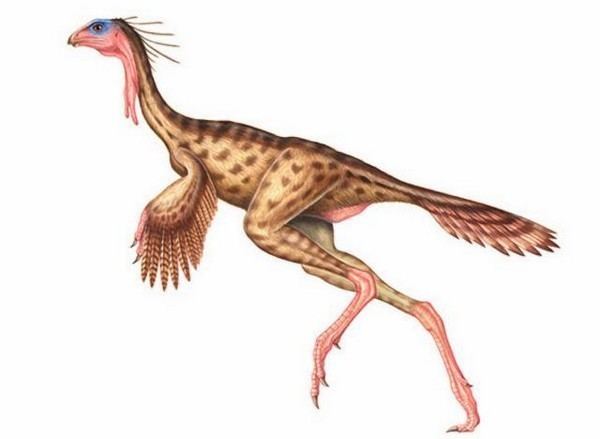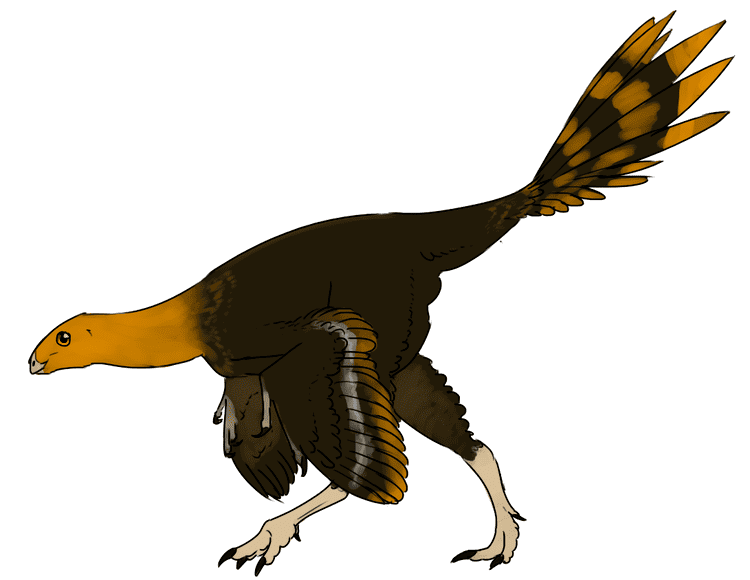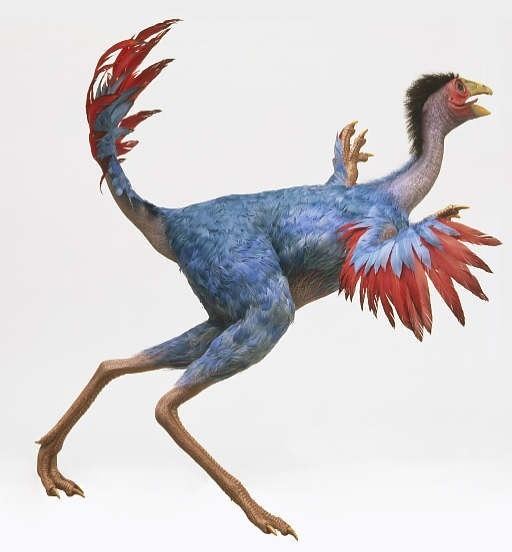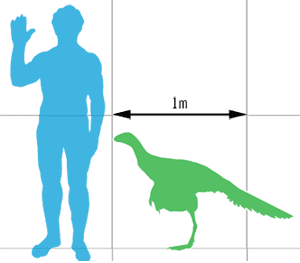Phylum Chordata | Class Reptilia Species †S. yixianensis Rank Genus | |
 | ||
Similar Nomingia, Sinovenator, Tianyulong, Zupaysaurus, Ilokelesia | ||
Similicaudipteryx, meaning "similar to Caudipteryx" (which itself means "tail feather"), is a genus of theropod dinosaur of the family Caudipteridae.
Contents

Discovery and naming

In 2007 the find of a new caudipterid was reported. In 2008 the new genus Similicaudipteryx, with as type species Similicaudipteryx yixianensis, was named and described by He Tao, Wang Xiaolin and Zhou Zonghe. The generic name, derived from Latin similis, "resembling", refers to its similarity to the closely related Caudipteryx. The specific name refers to its provenance from Yixian County. Presently, S. yixianensis is the only species named in the genus.

The holotype specimen, IVPP V 12556, was recovered from the Jiufotang Formation of northeastern China, dating to the early Cretaceous Period middle Aptian stage, about 120 million years ago or perhaps early Albian stage, about 112 million years old. It consists of a nearly complete skeleton of an adult individual compressed on a plate, that however lacks the skull, the front neck and the hands.

In 2010 two additional specimens were referred to Similicaudipteryx, one of a juvenile, STM4-1, and the other of a much larger juvenile, STM22-6. Both were reported as found in the Yixian Formation, dating to the early Aptian stage, about 124 million years ago.
In 2010 Gregory S. Paul renamed the species to Caudipteryx yixianensis, but this has found no acceptance.
Description

Similicaudipteryx is known from three specimens ranging from young juvenile to adult. It was a small oviraptorosaur similar to, but larger than, the perhaps closely related Caudipteryx. Paul in 2010 estimated the length at one metre, the weight at seven kilogrammes. Like Caudipteryx, it had a short snout with a downcurved lower jaw. It had relatively short arms and long legs. Similicaudipteryx also differed from its relatives by possessing a dagger-shaped pygostyle (the bone at the end of the tail to which feathers anchor in birds) consisting of the two most extreme tail vertebrae and several unique features of the back vertebrae. The pubic bone was exceptionally long relative to the ilium. The only other oviraptorosaur reported to have a pygostyle is Nomingia, though the feature is widespread in more advanced birds and appears to have evolved at least twice.
Feathers

The first Similicaudipteryx specimen lacked traces of feathers, but He and colleagues speculated that they were probably present based on its pygostyle, the anchor point of long tail feathers (rectrices) in modern birds. In 2010, two new specimens were described, both of which preserved feather traces. These specimens (both juveniles, though one closer to maturity than the other) showed that the feathers were similar to the related Caudipteryx, with long (symmetrical) vaned feathers on the hand and tail, and the rest of the body covered in simpler, downy feathers.
Paleobiology

The nature of the feathers preserved in the two immature Yixian specimens of Similicaudipteryx appeared to Xu and colleagues, who described the two feathered specimens, to change with age. The youngest specimen had relatively short primary feathers (those anchored to the hand) compared to its tail feathers. In the older specimen, the primary feathers were the same length as the tail feathers, and secondary feathers (those anchored to the lower arm) were also present. The primary feathers may have grown more slowly than the tail feathers, not reaching equal size until the animal was close to maturity, and the secondary feathers would not appear at all until this more mature stage. This suggests that the wing feathers had little use at a young age, only becoming fully developed with maturity.
Additionally, the youngest specimen's vaned feathers appeared to lack barbs except at the tip, instead consisting of a solid sheet. Xu and colleagues interpreted the stark differences in the feathers of the two specimens as primarily age-related. They speculated that hatchling Similicaudipteryx would have been covered in natal down like modern birds. As the animal aged, the down would be replaced by vaned pennaceous feathers on the hands and tail, but ribbon-like and primitive in form, similar to the tail feathers of Confuciusornis, Epidexipteryx, and some enantiornithines. These feathers would be lost through moulting as the animal aged, and replaced with more modern-style barbed feathers. The primary feathers grew more slowly than the tail feathers, not reaching equal size until the animal was close to maturity, and the secondary feathers would not appear at all until this more mature stage. This suggests that the wing feathers had little use at a young age, only becoming fully developed with maturity.
However, feather development specialist Richard Prum disputed the above interpretation of the feathers in a November 2010 letter to the journal Nature. Prum noted that the apparently ribbon-like structure of the juvenile's feathers were consistent with pennaceous feathers in the midst of moulting. In modern birds, new vaned feathers emerge from the feather follicle enclosed in a "pin feather", a solid tube covered in keratin. Usually, the tip of this tube will fall away first, leaving a structure identical to that seen in the Similicaudipteryx fossil. Later, the rest of the sheath falls away when the entire feather has fully developed. Prum also noted, as did Xu and his team, that the structure of the Similicaudipteryx feathers is fundamentally different from other prehistoric birds with ribbon-like tail feathers. In those other species, the ribbon portion is formed from a flattened and expanded rachis, or central quill, of the feather, with the feather barbs expanding out at the tip. In Similicaudipteryx, however, the "ribbon" like portion is the same width as the vaned tip. This is consistent with what is seen in feathers in the process of moulting. Prum concluded that rather than representing an instance of feathers changing in form as the animal aged, this specimen represents the first known fossil evidence of feather moulting.
Prum also noted that in modern birds, tail feathers moult sequentially, not simultaneously as in Similicauipteryx. However, the sequential moulting of modern birds is because the birds need to retain their ability to fly during the moult (except in penguins). For lineages more primitive than the advent of flight, like Similicaudipteryx, this would not have been an issue, and all the wing and tail feathers of primitive feathered theropods may have moulted simultaneously, more like penguins than flying birds.
Phylogeny
Similicaudipteryx was by its describers assigned to the Caudipteridae. An exact cladistic analysis of its position was not performed.
